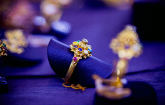BANGALORE, India, Jan. 24, 2025 /PRNewswire/ -- Luxury Goods Market is Segmented by Type [Luxury Watches & Jewelry, Apparels And Leather Goods, Luxury Personal Care & Cosmetics, Wines/Champagne And Spirits, Fragrances], by Application [Individual, Commercial].
The Global Luxury Goods Market was valued at USD 236820 Million in 2023 and is anticipated to reach USD 317490 Million by 2030, witnessing a CAGR of 4.2% during the forecast period 2024-2030.
Claim Your Free Report: https://reports.valuates.com/request/sample/QYRE-Auto-0R6457/Global_Luxury_Goods_Market
Major Factors Driving the Growth of Luxury Goods Market:
The market is characterized by the presence of renowned luxury brands that leverage heritage, craftsmanship, and exclusivity to attract affluent consumers. Continuous innovation in product design, sustainable practices, and digital transformation enhances the appeal and accessibility of luxury goods, catering to evolving consumer preferences.
The expansion into emerging markets and the rise of e-commerce platforms facilitate broader market reach and increased sales opportunities. Additionally, the growing trend of personalized and bespoke luxury items adds value and differentiation, further fueling the market growth.
View Full Report: https://reports.valuates.com/market-reports/QYRE-Auto-0R6457/global-luxury-goods
TRENDS INFLUENCING THE GROWTH OF THE LUXURY GOODS MARKET:
Luxury watches and jewelry drive the growth of the Luxury Goods Market by embodying status, craftsmanship, and timeless elegance that appeal to affluent consumers. These high-end products are symbols of wealth and prestige, often associated with heritage brands and exquisite design. The meticulous craftsmanship, use of premium materials such as gold, platinum, diamonds, and other precious stones, and the intricate detailing in luxury watches and jewelry enhance their desirability and exclusivity. Additionally, the investment value of luxury watches and jewelry attracts collectors and investors, further boosting demand. The rise of personalized and bespoke luxury items allows consumers to express their individuality, increasing the appeal of luxury watches and jewelry. The continuous innovation in design and the expansion of luxury brands into emerging markets significantly contribute to the growth of the Luxury Goods Market.
Apparels and leather goods significantly contribute to the growth of the Luxury Goods Market by offering high-quality, fashionable, and durable products that cater to discerning consumers. Luxury apparel brands are known for their superior materials, impeccable tailoring, and exclusive designs that set them apart from mass-market offerings. Leather goods, including handbags, belts, shoes, and accessories, are prized for their craftsmanship, longevity, and timeless style. The increasing demand for sustainable and ethically produced fashion items has also driven innovation in luxury apparel and leather goods, with brands adopting eco-friendly materials and production practices. Additionally, the rise of online luxury retail platforms and the globalization of fashion trends expand the reach of luxury apparels and leather goods to a broader international audience. The combination of quality, exclusivity, and brand prestige fuels the demand for luxury apparels and leather goods, thereby driving the growth of the Luxury Goods Market.
Individual consumers drive the growth of the Luxury Goods Market by seeking exclusive and high-status products that reflect their personal style and achievements. The aspiration to own luxury items is often linked to social status, personal success, and a desire for quality and uniqueness. Luxury brands cater to this demand by offering limited-edition products, personalized services, and exceptional customer experiences that resonate with individual preferences and lifestyles. The emotional connection and brand loyalty developed through exclusive marketing and high-touch retail experiences encourage repeat purchases and long-term relationships with consumers. Additionally, the influence of celebrities, influencers, and social media trends amplifies the desire for luxury goods among individual consumers, further fueling the market growth. The increasing global affluence and the rise of the middle and upper-middle classes in emerging economies expand the consumer base for luxury products, driving the expansion of the Luxury Goods Market.
Enhanced brand image is a pivotal factor driving the growth of the Luxury Goods Market, as it establishes trust, prestige, and recognition among consumers. Luxury brands invest heavily in marketing and branding strategies that highlight their heritage, craftsmanship, and exclusivity, creating a strong and desirable brand identity. The association of luxury goods with high quality, superior materials, and exceptional design enhances their perceived value and attracts discerning consumers. Additionally, collaborations with renowned designers, celebrities, and influencers further elevate the brand image and extend its reach to wider audiences. A strong brand image fosters loyalty and advocacy among consumers, encouraging repeat purchases and word-of-mouth referrals. The continuous effort to maintain and enhance brand reputation ensures that luxury goods remain highly sought after, thereby driving the growth of the Luxury Goods Market.
Digital transformation is a crucial factor driving the Luxury Goods Market, as it enables brands to reach a broader audience and enhance customer engagement through online platforms. The adoption of e-commerce, social media marketing, and digital advertising allows luxury brands to showcase their products to global consumers, breaking geographical barriers and expanding their market presence. Virtual showrooms, augmented reality (AR) experiences, and personalized online shopping interfaces provide immersive and interactive ways for consumers to explore and purchase luxury goods. Additionally, the use of data analytics and customer relationship management (CRM) systems helps brands understand consumer preferences and tailor their offerings accordingly. The integration of digital technologies enhances the accessibility and convenience of purchasing luxury items, attracting a new generation of tech-savvy consumers and supporting the growth of the Luxury Goods Market.
Sustainability and ethical practices are increasingly important factors driving the Luxury Goods Market, as consumers become more conscious of environmental and social responsibility. Luxury brands are adopting sustainable materials, eco-friendly production processes, and transparent supply chains to meet the growing demand for ethically produced products. Initiatives such as using recycled metals, responsibly sourced gemstones, and organic textiles enhance the sustainability profile of luxury goods, appealing to environmentally aware consumers. Additionally, ethical practices in labor and manufacturing, such as fair wages and safe working conditions, build trust and loyalty among consumers who prioritize corporate responsibility. The emphasis on sustainability and ethics not only aligns with global environmental goals but also differentiates luxury brands in a competitive market, driving the adoption of sustainable luxury goods and supporting the growth of the Luxury Goods Market.
Customization and personalization are essential factors driving the Luxury Goods Market, as they cater to the unique preferences and desires of individual consumers. Luxury brands offer bespoke services that allow customers to tailor products to their specific tastes, such as monogramming, custom fittings, and personalized design elements. This level of personalization enhances the exclusivity and emotional value of luxury items, making them more desirable and memorable for consumers. Personalized luxury goods also foster a deeper connection between the brand and the customer, encouraging brand loyalty and repeat purchases. Additionally, the use of advanced technologies like 3D printing and digital design tools enables brands to offer more intricate and customized options, expanding their product offerings and meeting the diverse needs of luxury consumers. The ability to provide customized and personalized experiences strengthens the appeal of luxury goods, driving the growth of the Luxury Goods Market.
Claim Yours Now! https://reports.valuates.com/api/directpaytoken?rcode=QYRE-Auto-0R6457&lic=single-user
LUXURY GOODS MARKET SHARE:
North America leads the market, driven by high disposable incomes, strong brand presence, and a large population of affluent consumers who prioritize luxury and exclusivity.
Europe follows closely, with its rich heritage in luxury fashion, jewelry, and automotive industries, coupled with a high concentration of luxury brand headquarters.
Key Companies:
● LVMH
● Kering
● Rolex
● Tiffany
● Coty
● Swatch
● Prada
● Financière Richemont
● Hermes
● Graff Diamonds
● Burberry
Purchase Regional Report: https://reports.valuates.com/request/regional/QYRE-Auto-0R6457/Global_Luxury_Goods_Market
SUBSCRIPTION
We have introduced a tailor-made subscription for our customers. Please leave a note in the Comment Section to know about our subscription plans.
DISCOVER MORE INSIGHTS: EXPLORE SIMILAR REPORTS!
- Luxury Goods Passport Market
- Affordable Luxury Goods Market
- Personal Luxury Goods market was valued at USD 268040 Million in 2023 and is anticipated to reach USD 322490 Million by 2030, witnessing a CAGR of 2.6% during the forecast period 2024-2030.
- Affordable Luxury Fashion market was valued at USD 17030 Million in 2023 and is anticipated to reach USD 28050 Million by 2030, witnessing a CAGR of 7.5% during the forecast period 2024-2030.
- Luxury Leather Goods Market was estimated to be worth USD 41450 Million in 2023 and is forecast to a readjusted size of USD 49550 Million by 2030 with a CAGR of 2.6% during the forecast period 2024-2030.
- Secondhand Luxury market was valued at USD 31190 Million in 2023 and is anticipated to reach USD 48120 Million by 2030, witnessing a CAGR of 6.7% during the forecast period 2024-2030.
- Luxury Packaging Market revenue was USD 20670 Million in 2022 and is forecast to a readjusted size of USD 32720 Million by 2029 with a CAGR of 6.7% during the forecast period (2023-2029).
- Luxury Doors Market revenue was USD 540 Million in 2022 and is forecast to a readjusted size of USD 727.6 Million by 2029 with a CAGR of 4.3% during the forecast period (2023-2029).
DISCOVER OUR VISION: VISIT ABOUT US!
Valuates offers in-depth market insights into various industries. Our extensive report repository is constantly updated to meet your changing industry analysis needs.
Our team of market analysts can help you select the best report covering your industry. We understand your niche region-specific requirements and that's why we offer customization of reports. With our customization in place, you can request for any particular information from a report that meets your market analysis needs.
To achieve a consistent view of the market, data is gathered from various primary and secondary sources, at each step, data triangulation methodologies are applied to reduce deviance and find a consistent view of the market. Each sample we share contains a detailed research methodology employed to generate the report. Please also reach our sales team to get the complete list of our data sources.
GET A FREE QUOTE
Valuates Reports
For U.S. Toll-Free Call 1-(315)-215-3225
WhatsApp: +91-9945648335
Website: https://reports.valuates.com
Blog: https://valuatestrends.blogspot.com/
Pinterest: https://in.pinterest.com/valuatesreports/
Twitter: https://twitter.com/valuatesreports
Facebook: https://www.facebook.com/valuatesreports/
YouTube: https://www.youtube.com/@valuatesreports6753
https://www.facebook.com/valuateskorean
https://www.facebook.com/valuatesspanish
https://www.facebook.com/valuatesjapanese
https://valuatesreportspanish.blogspot.com/
https://valuateskorean.blogspot.com/
https://valuatesgerman.blogspot.com/
https://valuatesreportjapanese.blogspot.com/
SOURCE Valuates Reports

WANT YOUR COMPANY'S NEWS FEATURED ON PRNEWSWIRE.COM?
Newsrooms &
Influencers
Digital Media
Outlets
Journalists
Opted In





Share this article